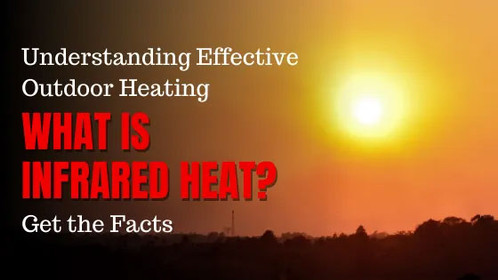What is Infrared Heat? Understanding Effective Outdoor Heating. Get the Facts.
Posted by Eric Kahn on Jul 31st 2023
What do the terms “infrared heat” and “true infrared” really mean?
Many people think that only electric patio heaters provide infrared heat and that gas patio heaters don’t. We have even read articles that state, falsely, that gas patio heaters only heat the air and that electric patio heaters are infrared and, therefore, more efficient. In reality, gas patio heaters are infrared too.
When you understand how patio heaters provide heat, you can make a more informed decision about what kind of outdoor heaters are best for your outdoor environment.

What is Infrared Heat exactly?
Infrared heat is also commonly referred to as radiant heat. The term “radiant heat” is sometimes used for in-floor heaters and radiators, but that’s not what this post is about.
Scientifically speaking, infrared heat travels at the speed of light until it comes in contact with an object. On a cold day, when the sun comes out from behind the cloud, you feel the radiant or infrared heat immediately. It feels good even though the sun’s rays have traveled 93 million miles. The air temperature hasn’t changed. What you are feeling is infrared radiant heat.
Here on Earth, infrared radiant heat sources include campfires, toasters, and patio heaters. A patio heater’s infrared rays may travel ten or fifteen feet from the heat source to heat objects like the furniture, the floor, people, and their clothes. This kind of heat touches anything in the sight-lines of the heater.
What kinds of infrared heat do different patio heaters generate?
Essentially, all patio heaters create infrared heat.
Electric patio heaters come in the short, medium, and long-wave spectrum of infrared waves.
-
Short wave electric patio heaters have a higher temperature element, and emit more light.
-
Long wave electric patio heaters we have found to be ineffective outdoors.
-
Medium wave electric patio heaters provide a good amount of heat and a soft, warm glow.
Gas patio heaters burn gas to heat a surface that then emits medium-wave infrared radiant heat.
-
In high-intensity overhead gas patio heaters (i.e. SunPak) the infrared radiant heat source is perforated ceramic tiles. The glowing-orange-hot tiles are in the range of 1500°F to 1600°F.
-
In low-intensity tube patio heaters, a burner at one end heats a long metal tube to about 1100°F, and the metal tube is the infrared radiant heat source. The flame is not visible and the heaters do not glow.
-
In upright, mushroom-type heaters (i.e. Patio Comfort), the radiant surface is a metal emitter grid that glows orange.
-
In upright glass-tube heaters, the heat is primarily from the flame, however infrared radiation is reduced by passing through the glass tube because glass is an insulator.
Which infrared outdoor heaters are more efficient?
The infrared radiant efficiency of a heater conversely affects how much incidental convection heat is created. Electric patio heaters are more efficient, once the electricity gets to the heater. (There is some inefficiency in electricity generation and transmission through power lines.) Gas patio heaters lose some infrared radiant efficiency in escaping hot combustion gasses. In a covered patio, not all convection heat is lost immediately.
Despite electric patio heaters greater internal efficiency, the cost of operating gas patio heaters, for a similar amount of infrared radiant heat, is typically a fraction of the cost of operating electric patio heaters. The difference in the cost varies regionally. Here in the San Francisco Bay Area, where PG&E electricity is very expensive, it is four to five times more expensive to operate an electric patio heater than a gas patio heater producing a similar amount of heat.
That difference in operating cost may not matter much to a homeowner who uses a small number of patio heaters, a small number of hours, a small number of times per year. However, that same difference in operating cost can make a huge difference to a restaurant who operates quite a number of patio heaters, for several hours, and many days of the year.
Understanding the differences between radiant heat, convection heat, and conduction heat
Infrared radiant heat is generated by all gas and electric patio heaters. This kind of heat travels through space and heats objects as the rays contact them. When you wear dark clothing, you will get warmed more from patio heaters than if you wear light clothing.
Convection heat is currents that are created as hot air rises and cool air falls. Some hot air does rise from patio heaters, and so there is some incidental convection heat created, especially from gas patio heaters. This provides only a little benefit in a covered area and no benefit in an uncovered area. Convection heat loss, from the wind, can affect your overall comfort.
Conduction heat is when heat is transferred through direct contact. Touching a cold surface conducts heat from your body. That is why patio heaters work best at creating a warm and comforting environment after they have been on long enough to heat the tables and chairs, which would conduct heat from you when cold, and conduct heat into you once warmed up by infrared heat waves from patio heaters.
If you have any questions or need help finding the best outdoor infrared heating solutions for your environment, please give us a call at 707-345-4000.
© 2020 Alfresco Heating. All rights reserved. May not be copied or used without express permission

